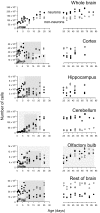Changing numbers of neuronal and non-neuronal cells underlie postnatal brain growth in the rat
- PMID: 19666520
- PMCID: PMC2729028
- DOI: 10.1073/pnas.0804650106
Changing numbers of neuronal and non-neuronal cells underlie postnatal brain growth in the rat
Abstract
The rat brain increases >6x in mass from birth to adulthood, presumably through the addition of glial cells and increasing neuronal size, without the addition of neurons. To test this hypothesis, here we investigate quantitatively the postnatal changes in the total number of neuronal and non-neuronal cells in the developing rat brain, and examine how these changes correlate with brain growth. Total numbers of cells were determined with the isotropic fractionator in the brains of 53 Wistar rats, from birth to young adulthood. We find that at birth, >90% of the cells in the rat brain are neurons. Following a dormant period of approximately 3 days after birth, the net number of neurons in the cerebral cortex, hippocampus, and remaining tissue (excluding cerebellum and olfactory bulb) doubles during the first week, then is reduced by 70% during the second postnatal week, concurrently with net gliogenesis. A second round of net addition of 6 million neurons is observed in the cerebral cortex over the following 2 weeks. During the first postnatal week, brain growth relates mainly to increased numbers of neurons of larger average size. In the second and third weeks, it correlates with increased numbers of non-neuronal cells that are smaller in size than the preexisting neurons. Postnatal rat brain development is thus characterized by dramatic changes in the cellular composition of the brain, whose growth is governed by different combinations of cell addition and loss, and changes in average cell size during the first months after birth.
Conflict of interest statement
The authors declare no conflict of interest.
Figures

References
-
- Bayer SA. Cellular aspects of brain development. Neurotoxicol. 1989;10:307–320. - PubMed
-
- Altman J. Autoradiographic and histological studies of postnatal neurogenesis. III. Dating the time of production and onset of differentiation of cerebellar microneurons in rat. J Comp Neurol. 1969;136:269–293. - PubMed
-
- Bayer SA. 3H-thymidine-radiographic studies of neurogenesis in the rat olfactory bulb. Exp Brain Res. 1983;50:329–340. - PubMed
-
- Bayer SA. Development of the hippocampal region in the rat. II. Morphogenesis during embryonic and early postnatal life. J Comp Neurol. 1980;190:115–134. - PubMed
-
- Clarke PGH. Neuronal death in the development of the vertebrate nervous system. Trends Neurosci. 1985;8:345–349.
Publication types
MeSH terms
LinkOut - more resources
Full Text Sources

